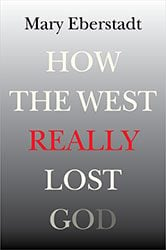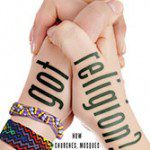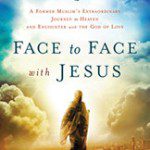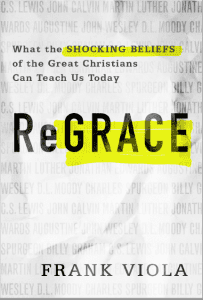 About halfway through grad school course work, I had a professor who asked each student in our class what we wanted to do with our lives once we’d earned our Ph.D.’s. His enthusiasm and encouragement for the future professors, administrators, community activists, and citizen-scholars in the group was ebullient.
About halfway through grad school course work, I had a professor who asked each student in our class what we wanted to do with our lives once we’d earned our Ph.D.’s. His enthusiasm and encouragement for the future professors, administrators, community activists, and citizen-scholars in the group was ebullient.
When I said I wanted to be a mother?
Crickets.
By that point in the program though, I’d already pushed what is perhaps an even more taboo button in academia: I’m a Christian. Now, I’m hardly one to bemoan American Christians as “persecuted” (a notion I left firmly behind on the closing page of Randy Alcorn’s Safely Home), but I will say this: during week one of grad school, I was warned by no less than three fellow students (who were self-professed “in-the-closet Christians”) that I’d be better off keeping my head down, and at my first advising meeting, when I mentioned I wanted to study online Christian communities, I was told “Good luck finding a dissertation committee interested in working with you.”
Fortunately, I was able to find a full committee of open-minded, excellent scholars willing to work with me without requiring I partition or ignore my faith. Fortunately as well, I have been able to simultaneously embark on an academic career while mothering two little boys. But the awareness that academia is not the healthiest scene for either family-minded professionals or Christians has never left me. And—while the ivory tower is hardly a microcosm of larger American culture on all issues—this is an experience that is probably not unfamiliar to many. Indeed, we need only turn on the TV or radio as election season approaches to hear conservatives lamenting the decline of religion and the traditional family and liberals counting these same evolutions as progress.
Mary Eberstadt—in How the West Really Lost God—has taken these two trends and speculates that it is no coincidence we are experiencing them simultaneously. In fact, she argues that while many factors have been explored in an effort to explain the secularization of the West (listing, for example, “urbanization, industrialization, belief and disbelief, technology, [and] shrinking population” as influences that contribute in various ways), the “Family Factor,” or the decline of the traditional family (by which she means the “family built on irreducible biological ties,” i.e., a mother, father, and biological children), is the only factor which can fully account for the trend. At first glance, the argument might seem an all-too-convenient one to forward a conservative political agenda. However, Eberstadt makes it clear from the get-go that she is interested solely in following where concrete statistical and sociological evidence leads and that after extensive research and consideration of many alternatives, her conclusion—that there is a “double-helix” of Christianity and the family in which where one thrives the other does as well—has proved irrefutable.
This is the kind of book I like to play the “But what about…” game with. That is, having recognized how helpful—in our heavily partisan political climate—Eberstadt’s argument might be to serve the Republican party, I played devil’s advocate, asking “But what about” this or that various point at every opportunity. And I have to say that, having read many of Eberstadt’s chapters—each a rich mine of research—two or three times, it will take a better eye and a more critical mind than mine to crack her argument. By page 122, I had written “This claim seems airtight…” no less than six times in my margins.
The progression of Eberstadt’s argument is smooth and logical, her supporting research is thorough, and her knowledge base is broad (Karl Marx, Friedrich Nietzsche, Sigmund Freud, and Matthew Arnold, for example, are referenced with equal ease) . She begins by handling a variety of alternate explanations that scholars have offered for secularization and explaining where they come up short. These include the “comfort theory” (the idea that the “imaginary comforts” of religion eventually became no longer necessary) and the theories that secularization was caused by the rise of the influences of science, the Enlightenment, and rationalism; the first and second world wars; or material. She then moves on to describe the extensive research showing both historic and present day connections between declines in fertility and declines in religion. As case studies, she offers the simultaneous declines in fertility and religion in 18th century France, 19th century Britain, and 20th century Ireland. By contrast, she offers the post-World War II Baby Boom and concurrent surge in religion as evidence that the trend works both ways. In terms of our most recent downturn in popularity of both the traditional family and Christianity—a movement that she dates to the 1960s—she identifies the approval of the birth control pill in 1960 as the determining factor. Extramarital sex became easier, and the sexual revolution forever changed our culture, leading Eberstadt to deem the birth control pill as the force that “contributed to the weakening of family bonds as no other single technological force in history.”
The reasons for this connection between the traditional family and Christianity, Eberstadt speculates, are myriad. To start, as family structures changed—via divorce, single parenthood, widespread use of contraception, legal abortion, and declines in birthrates—we found ourselves increasingly in a position where government—the welfare state—was taking over the responsibilities that traditionally fell to the family in terms of care for family members. Furthermore, because the story of Christianity centers on an understanding of the traditional family, as “family illiteracy” abounded, Eberstadt found “religious illiteracy” to abound as well: we are no longer, she claims, developing via firsthand experience the understanding of family that makes the Christian story so compelling and powerful. Also, as traditional family structures become less common, the powerful experience of building a traditional family—through birth and child raising (women habitually have been the most active in going to church)—which has often inspired families to pass on or begin religious engagement has diminished. Millennials and Generation X-ers are much less likely to share their religion with their children than previous generations. In addition, as Western culture’s views on what is deemed appropriate sexually evolved, the church contributed to its own decline as various sectors began to allow these changes to direct changes in doctrine. Eberstadt notes that doctrine altered to accommodate changing family structures can be traced as far back as the Reformation with leniency toward divorce, then leniency toward artificial contraception in the 1930s, then leniency toward homosexuality in the 2000s, and in each case, Eberstadt notes that the “attempt to knead the traditional Christian moral code into something softer and more palatable to modern sensibilities…[led to] the ongoing and inarguable institutional decline of the churches that have tried it.” This weakening has been dramatic, encompassing demographic and financial declines and deteriorations in mission and morale.
Having made the case that it is only the “Family Factor” which can fully account for the decline of Christianity in the West, Eberstadt concludes by asking two key questions: Is there hope for Christianity? And why—especially for those non-religious readers—should we even care? Among the reasons for optimism (and Eberstadt qualifies by saying that the reasons for pessimism are strong and that Christianity has much to overcome before reestablishing its position as a thriving religion in the West), Eberstadt lists the fact that historically, during times of calamity (and the current state of decline in the Western church might well qualify as calamity), Christianity has often experienced its greatest revivals and the fact that the welfare state is—as we are already seeing—ultimately unsustainable, so once citizens begin to see its failures they might well return to depending on family for this support again, leading to an upsurge in religion. If these reasons for optimism seem weak, Eberstadt concludes by making a strong case that we should not passively stand by and wait to see what happens, arguing rather that it is in the best interest of society to actively promote Christianity and the traditional family. Her reasoning is that, regardless of one’s individual point of view or political persuasion, cultures where Christianity and the traditional family thrive tend to thrive as societies more broadly as well. She points to the facts that Christianity has served as a force for good in modern society and that believers tend to give more to charity; live longer, healthier, and happier lives; and be less likely to commit crime, concluding that when we ask if it is in society’s best interest to encourage the revival and practice of Christianity, “The answer is: only insofar as it is in society’s interest to encourage quality of life, enhanced health, happiness, coping, less crime, less depression, and other such benefits associated with religious involvement.” And of course, what society wouldn’t be interested in that?
While I see no substantial reason to critique Eberstadt’s argument, it is worth noting that this is an academic text, committed to objectivity and the highest levels of scholarship. She does not mention or even hint at her own political or religious persuasion, and I forced myself to avoid Googling her biography or affiliations before finishing the book to allow myself to see if in small ways she might show her hand or a personal agenda in the matter (I found nothing). That said, I think it would be very interesting (and in fact, of the utmost importance) for scholars, politicians, theologians, and pastors to now take Eberstadt’s thesis and suggest what might be done to more purposefully bring about this revival of faith and the family. In other words, how might we translate Eberstadt’s theory into action?
Looking back on my own experience with higher education’s perspective on the traditional family and Christianity, I see that, especially in certain echelons of society, convincing others of the value of these forces for society may be an uphill battle. Eberstadt notes that in countries like France, the government has actually had to revise the tax code (to some limited success) as a way of encouraging family-building in response to a steep decline in birthrate, and perhaps policy-making and/or revision will be necessary. But, as I shared from my experience as well, even in the most secular realms (and academia is surely one!), there are people who already are in (closeted) agreement or who are open-minded enough to consider the implications and appreciate the value of Eberstadt’s argument. In fact, I’d imagine her book would serve well as a textbook and starting point for discussion in college classrooms. It is the kind of text that will be easy to write off for those who read only the blurbs on the back or brief reviews of its contents or whose political blinders are too firmly in place to consider alternatives, but impossible to ignore for those who take the time to fully consume, absorb, consider the implications and applications of her thesis.
To read an excerpt from How the West Really Lost God, visit the Patheos Book Club here.
 Amber M. Stamper holds a Ph.D. in English (Rhetoric and Composition) and is an Assistant Professor of Language, Literature, and Communication at Elizabeth City State University in North Carolina. Her research and publications center on religious rhetoric and communication, especially issues of Christian evangelism and the digital church.
Amber M. Stamper holds a Ph.D. in English (Rhetoric and Composition) and is an Assistant Professor of Language, Literature, and Communication at Elizabeth City State University in North Carolina. Her research and publications center on religious rhetoric and communication, especially issues of Christian evangelism and the digital church.













